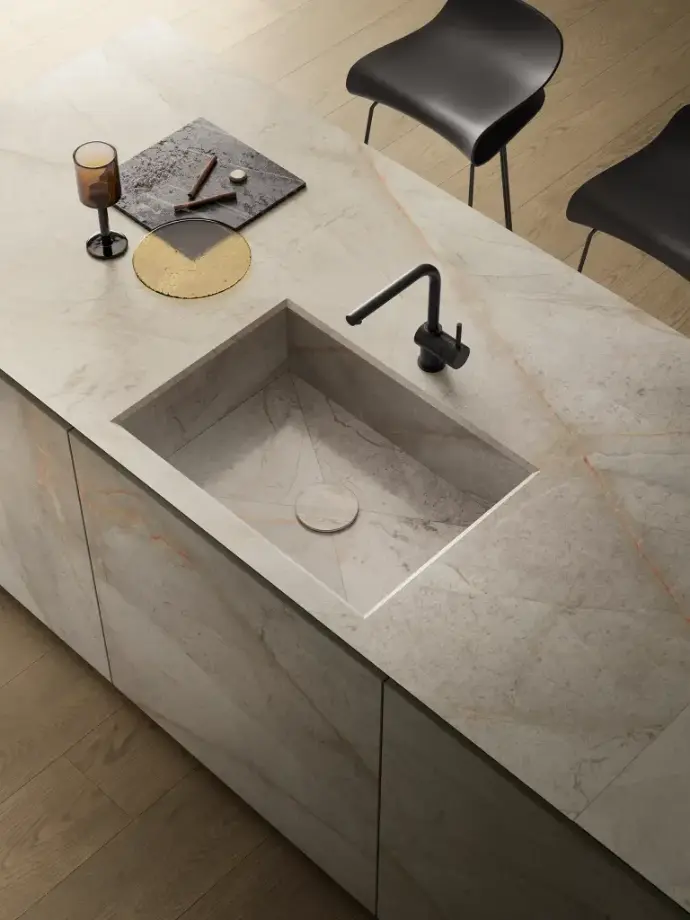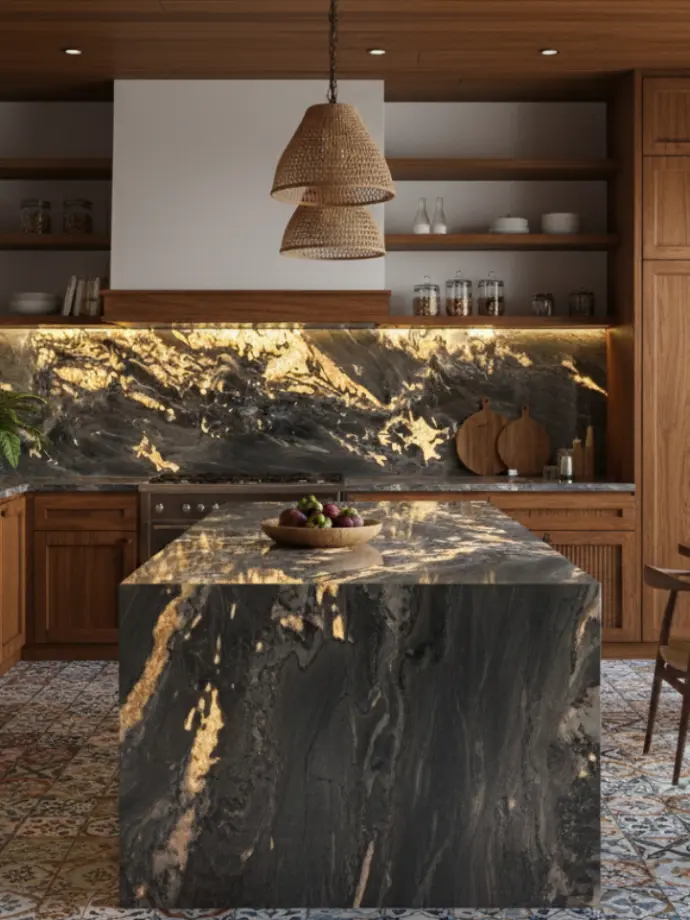In the evolving world of interior design and architecture, choosing the right surface material is essential not only for aesthetics but also for long-term durability and functionality. Among the myriad of options available today, sintered stone and porcelain slabs have emerged as two of the most popular materials for countertops, flooring, walls, and even exterior cladding. Despite their similar appearances and overlapping applications, these materials are distinct in their composition, production, performance, and overall value. This blog post offers an in-depth comparison between sintered stone and porcelain slabs, helping homeowners, designers, and builders make informed decisions.
What is Sintered Stone?
Sintered stone is a manufactured surface material created through a process known as sintering, where natural minerals are exposed to extreme heat and pressure to form a solid, non-porous slab. The process mimics the natural geological formation of rocks, but compresses millions of years into just a few hours in a factory setting. Sintered stone typically comprises a blend of minerals such as quartz, feldspar, silica, and clay, but may also include other natural oxides depending on the manufacturer.
Key features of sintered stone include:
- High resistance to scratches, stains, chemicals, and heat
- Non-porous surface, making it hygienic and easy to clean
- UV stability, suitable for both indoor and outdoor use
- Eco-friendly production, often utilizing recyclable materials
- Wide variety of colours, patterns, and finishes
Popular brands producing sintered stone include Neolith, Dekton, and Lapitec, each offering a diverse array of options tailored to contemporary design needs.
What is Porcelain Slab?
Porcelain slabs are large-format tiles made from refined clay (kaolin) and other minerals, fired at very high temperatures to produce a hard, durable, and elegant surface material. Porcelain has a long history, dating back to ancient China, but the development of porcelain slabs is a modern innovation, allowing for seamless installations with minimal grout lines.
Key features of porcelain slabs include:
- Exceptional resistance to water absorption due to its dense, vitrified surface
- Impressive resistance to chemicals, stains, and UV radiation
- Wide range of colours, textures, and realistic imitations of stone, wood, or concrete
- Lightweight and easy to install compared to natural stone
- Suitable for both interior and exterior applications
Brands such as Laminam, Atlas Plan, Florim, and Porcelanosa have established porcelain slabs as a staple of modern design.
Comparing Sintered Stone and Porcelain Slab
Despite their similarities, sintered stone and porcelain slabs differ in several important ways. The following sections dive deeper into their characteristics and performance.
Composition and Manufacturing
Sintered Stone: Created using a blend of natural minerals that are subjected to intense heat (over 1200°C) and pressure (up to 400 bar) in a process called sintering. The result is a slab that replicates the density and durability of natural stone, often outperforming it in key areas.
Porcelain Slab: Made primarily from refined clay and feldspar, fired at high temperatures (around 1200°C), but without the same level of pressure as sintered stone. The vitrification process yields a non-porous, glass-like surface, although the material structure is different from sintered stone.
Appearance and Design Options
Sintered Stone: Offers sophisticated colours, patterns, and finishes, including matte, polished, and textured surfaces. The manufacturing process allows for custom designs, realistic stone imitations, and unique artistic effects. Thickness options typically range from 6mm to 30mm.
Porcelain Slab: Porcelain excels in mimicking natural materials, especially marble and wood, using advanced digital printing technology. Slabs are available in various thicknesses, usually between 3mm and 20mm, and can be produced in very large formats, up to 160x320cm.
Durability and Performance
Sintered Stone: Extremely durable, resistant to impact, abrasion, and thermal shock. Its dense structure makes it less likely to chip or crack compared to porcelain. Suitable for high-traffic areas, outdoor kitchens, and facades exposed to harsh weather.
Porcelain Slab: Highly durable and resistant to wear, but may be more susceptible to edge chipping if not handled or installed correctly. While resilient under most conditions, its slightly lower density compared to sintered stone can affect long-term durability in some heavy-use scenarios.
Maintenance and Hygiene
Both materials are non-porous and easy to clean, requiring only mild soap and water for everyday maintenance. Sintered stone’s ultra-dense surface is less likely to harbour bacteria or stains, making it ideal for kitchens and bathrooms. Porcelain slabs also resist mould and mildew, making them a hygienic choice for all environments.
Installation and Applications
Sintered Stone: Heavier and denser than porcelain slabs, sintered stone may require additional support during installation, especially for countertops and wall cladding. Its strength allows for large overhangs and minimal seams.
Porcelain Slab: Lighter and easier to handle, making it suitable for wall panels, flooring, and renovations where weight is a concern. Large format slabs reduce grout lines, providing a sleek, seamless look, especially in open-plan spaces.
Cost Considerations
Sintered stone is generally more expensive than porcelain slabs due to its advanced manufacturing process and higher density. However, the investment may pay off in terms of longevity and performance, especially in demanding environments. Porcelain slabs offer an affordable alternative with excellent aesthetics and durability for most residential and commercial applications.
Pros and Cons
Sintered Stone
- Pros: Superior durability, custom design options, UV stability, excellent hygiene, suitable for outdoor use
- Cons: Higher cost, heavier weight, may require specialized installation
Porcelain Slab
- Pros: Affordability, lightweight, diverse design options, easy installation
- Cons: May be more brittle at the edges, lower density, less suitable for extreme heavy-duty applications
Environmental Impact
Both materials are eco-friendly compared to natural stone, reducing quarrying and material waste. Sintered stone often incorporates recycled content and is fully recyclable, while porcelain slabs are made from abundant natural resources and can also be recycled. Manufacturing processes for both materials continue to improve in terms of energy efficiency and emissions.
Which Should You Choose?
The decision between sintered stone and porcelain slab depends on your specific needs. If you require maximum durability, outdoor suitability, and custom design elements, sintered stone may be the better choice. For projects where budget, ease of installation, and versatility are priorities, porcelain slab offers outstanding value.
Conclusion
Both sintered stone and porcelain slabs embody the best of modern engineering, offering beautiful, resilient, and sustainable solutions for every space. Understanding their differences—composition, performance, cost, and installation—empowers you to select the ideal surface for your next project, ensuring lasting beauty and utility. Whether you opt for the cutting-edge innovation of sintered stone or the timeless elegance of porcelain, your surfaces will reflect both your taste and the technological progress shaping contemporary interiors.

